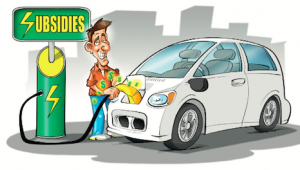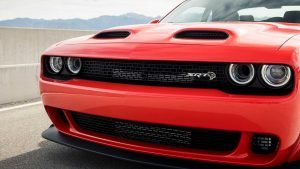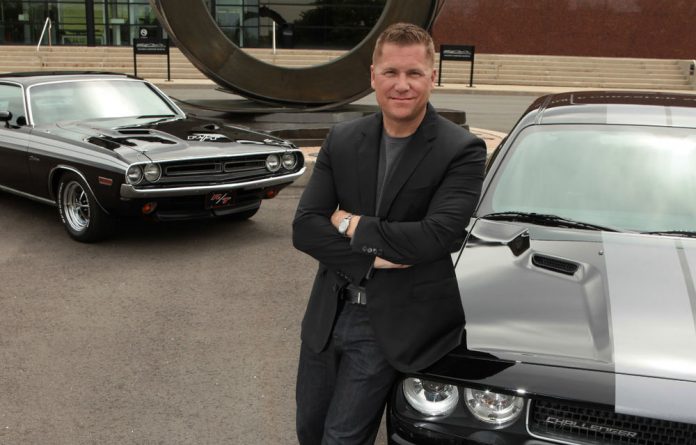Tim Kuniskis – the head of Dodge – is in a tough spot. He knows perfectly well that “electrification” is not what people who buy Dodge vehicles want. If they did want it, they would be buying electrified cars rather than electrifying cars, which very few car companies still make.
And which Dodge does.
And sells, lots of.
The fact that Dodge can’t build V8-powered Chargers, Challengers and Durangos fast enough to meet demand for them without any need to use tax breaks to shave thousands off the sticker price as a bribe to get people to buy them, says everything about the desirability of these vehicles – as juxtaposed with the confected desirability of electrified cars like Teslas, which would stop selling tomorrow if the tax-bribes were rescinded today.
Even more telling as regards the desire for Dodges as they are is the fact that they are as they are – which is the same as they have been for the past going on fifteen years now.
This is unprecedented longevity for a “platform” – car industry-speak for a vehicle’s basic or underlying chassis and drivetrain. Most new cars last about 4-5 years before they are fundamentally rebooted; ten years is exceptional. Fifteen is almost unheard of in the modern era.
Dodge has not had to “update” the Charger or Challenger (which is basically a two-door Charger) significantly since the early-mid-2000s because people like – and buy – them as they are. They do not want “change.” They do not want a tiny, turbocharged four cylinder engine, a CVT automatic and front-wheel-drive. They are not asking for batteries and electric motors, either.
They are champing at the bit to pay their hard-earnd money for heavy-hitting V8-powered, rear-wheel-drive American cars, at prices average Americans can afford. The kinds of cars no one else makes anymore.
Dodge owns this market.
Electrocuting it would be just that.
Kuniskis knows it, too. But he feels obliged to play their game. Or at least, to mouth the pieties. He says: “We want to explain to people, Dodge muscle car first. And by the way, it happens to have electrification to make it better.”
Italics added.
No! God help us, no, Please, Tim. This would ruin everything, as a spoonful of poo ruins a gallon of even the best ice cream.
How would adding the weight and expense and complexity of electric motors make a Charger or Challenger “better”? Would it be quicker? Would the additional weight be counterbalanced by the additional power? Perhaps. But inevitably it will cost more – to buy and to fix – and that will exclude more buyers from your showrooms, unless they are tax-bribed to enter.
The Challenger R/T is a car the average American can still afford because it can be bought for about $35k. Will you be able to sell a partially electrified Challenger for $40K? Without resorting to tax-bribes and becoming thereby not a seller of honest goods but another form of rent-seeking parasite, like Elon Musk?
Like General Motors?
Consider – please – how buyers of Ram trucks generally avoid the partially electrified V6 version of the current half-ton Ram 1500. Buyers prefer – and buy – the Hemi V8, without the electric battery pack under the rear seat.
Electrification has its place, certainly. Or at least, it might. It’d be interesting to find out where – which would be instantly obvious if the tax-bribes and “mandates” went away tomorrow. Probably, there would be a few very high-end electric cars like the Tesla S – which a very few very affluent EV partisans would buy, even without the tax-bribe. Not because the cars make any kind of practical or economic sense but simply because they like the idea of electric cars and really like the idea of a very (temporarily) quick electric car and are willing to pay a premium – and their own money – for it.
There might also be some EVs on the other end of the spectrum. The low-cost end, which is the natural habitat of the EV, given technology and economics. Or would be, if both the former and the latter were allowed to exercise their discipline. There would probably be small, light, highly efficient EVs cheaper to buy and operate than a gas engined subcompact economy car. Probably at the cost of not being able to travel much farther than 100 miles on a charge or go much faster than 70 MPH. But that would be plenty sufficient for the short-range commuting that EVs are suited to, given the state of existing technology.
People would probably buy such cars, without being bribed to.
Instead, the car industry is forced by artificialities – mandates and regulations – to design and build EVs that cannot compete on practical or economic terms with gas-engined cars and made to “sell” them at a loss to “buyers” – who must be tax-bribed to “buy” them.
That is bad enough, for the thuggery and mobility regression it represents.
Far worse is the threat to alternatives it represents.
Dodge as it is is a thorn in the side of the electrification agenda. The ongoing, spectacular sales success of heavy-hitting, V8-powered American muscle cars like the Charger and Challenger (and similar in function V8-powered SUVs like the Durango) stands incandescent as a repudiation and an affront, in the same way that the annoyingly persistent health of people who never wore the loathsome psychological conditioning devices that are styled “masks” provides a devastating counterpoint to the engineered mass hysteria.
Neither can be allowed to serve such an illuminatory purpose – for exactly that reason.
Kuniskis knows it, too – as regards Dodge. Or at least, one hopes so. An electrified Dodge will be the end of Dodge. The reason for this diagnosis is obvious. Electrified Dodges would be the same as electrified everything else.
So why bother with Dodge?
Perhaps a Charger or Challenger would be quicker with battery-electric assist (or entirely battery-electric). But quickness is something others sell. What would be the difference between an electrified Charger and a Tesla? Other than the appearance?
Is a shell enough?
Scoops that no longer do?
What makes a Dodge desirable is that it is different, in the first place. There is literally nothing else like a Charger Hellcat Redeye. A Tesla S may offer comparable quickness, but that is to miss the point entirely. It is not quickness that fundamentally defines a Charger or a Challenger or a Durango. It is the sound and rumble of that uniquely Dodge V8 and everything it represents – which is the antithesis of everything electrified homogeneity embodies.
Please, Tim – hold the line. Don’t let them ruin a good thing by making it the same thing.
. . .
Got a question about cars, Libertarian politics – or anything else? Click on the “ask Eric” link and send ’em in! Or email me at EPeters952@yahoo.com if the @!** “ask Eric” button doesn’t work!
If you like what you’ve found here please consider supporting EPautos.
We depend on you to keep the wheels turning!
Our donate button is here.
If you prefer not to use PayPal, our mailing address is:
EPautos
721 Hummingbird Lane SE
Copper Hill, VA 24079
PS: Get an EPautos magnet or sticker or coaster in return for a $20 or more one-time donation or a $10 or more monthly recurring donation. (Please be sure to tell us you want a magnet or sticker or coaster – and also, provide an address, so we know where to mail the thing!)
My eBook about car buying (new and used) is also available for your favorite price – free! Click here. If that fails, email me at EPeters952@yahoo.com and I will send you a copy directly!












As a Chrysler employee and tech I can attest to how good the newer dodges are in all categories. However I would never own one, though I work on them for a living I hate all new cars and trucks. Over complicated, cheaply built, woefully inefficient smartphones with wheels, no matter the brand. Went round with the boss about the newer generation of trucks, and how they are way better then the old ones. He touts his new ’21 ram 1500 that averages 12-15 mpg empty, 10-12 towing anything, with 5.7L engine and 8sp trans. I then pointed out a few things to bring him into perspective. My 1988 Chevy K1500 with 5.7L and 4sp trans averages 16-18 mpg empty, last week I made the 100mile trip up to my folks’ farm to retrieve my 1945 John Deere tractor and 2 smaller deeres, all together towing about 7k lb, averaged 14mpg. That’s running in 3rd gear on the freeway, doing 65, towing 7k, in a 30+ yr old truck, with 370k miles on it. Kinda humbled him a bit I think. Plus there is no possible way to make any newer truck sound anywhere close to as good as a sbc with true duals and continental glasspacks. You could offer me the most loaded brand new 90k$ truck for my old $2500 chev and id laugh in your face and tell ya to kick rocks.
Amen, Rusty –
The shame is what could be. Were it not for all the crap, Dodge (and the rest) could build trucks that were better – and cost less – than those ’80s and ’90s-era trucks we love. Imagine the current Hemi without the cylinder management, with a simple four speed OD automatic (or five speed manual) in a truck that weighed the same as your ’88. No body control modules, no LCD touchscreens. Just a refinement of the apotheosis reached some 25-30 years ago.
Hence the next part of the “war plan” is to find a decent PU, Dodge, “Ferd”, or “SHivvy”, preferably with a six-banger (the GMC 292 straight six and the Ford 300 Six are just about as bulletproof as the Mopar Slant Six) and standard shift. The idea is that this beast will be a WORK truck, a DAILY driver, and something I can fix as needed. Along with the Plymouth Valiant or VW Bettle. Methnks, unless my “beloved Snips” has something in mind, my 2020 (con)FUsion will be the last modern ride I ever buy. Given that she pulls down even slightly more than yours truly, hey, if SHE’S buying, OK. Else I refuse any more trips on the car debt treadmill, thank you very much.
Eric, since you do review these new rides, may you can answer what the auto makers say: just what the HELL does a “body control” module actually DO? Please correct me if I err, but isn’t the car’s “body” simply a mass of SHEET METAL, coated with paint, and some glass where needed? I recall seeing Scotty Kilmer, beside screaming and gesturing wildly, in one of his videos, using some $4,000 specialized tablet with an OBD-II dongle, to read the “body modules” on a troubled Chevy Suburban.
Shit, will I be the last guy to knows how to replace and/or adjust a set of ignition points and TIME an engine?
Hi Dougl,
Basically, it’s a computer for – as an example – the power windows and locks. These items are no longer controlled, as in the past, by a simple switch/wires. Instead, the body control module signals the accessory to operate. It has made these systems vastly more complicated but easier to install on the assembly line as . . . modules (and to achieve a bleak uniformity of operation). There is also the prospect of $$$ when these components fail and require replacement.
If power windows failed because of this they are no doubt still using brush motors. So for a $6 relay and some wire and maybe a fuse holder the BCM could be entirely by-passed.
Since the “old school” circuitry for power windows and door locks wasn’t all that complicated, I’d say, given the relative low cost to make a “one-size-fits-all” BCM, as most vehicles are “four door” in configuration, the intent was to have something that (1) had a better chance of making it through the proffered “bumper-to-bumper” warranty (2) was easier to program with related systems and (3) when the thing DOES finally crap, it’s so damned expensive to replace, or the auto maker simply doesn’t make them available, hence “Un-obtanium”. Ergo, it’s another way to achieve “planned obsolescence”. Even the very name seems a deliberate effort to confuse even those with a modicum of tech savvy.
In order to reduce wiring all the interior electrical functions are handled by a network system. The BCM is the central hub or brain of that network.
I am going to break into my savings and buy a Hellcat Challenger! I have a 2013 Challenger RT and a 2017 392 Challenger the wife drives,and I need a Hellcat,prefer Redeye but will see..Yes our 2 kids fit perfectly fine in the back of our Challenger!
My brother comments here a lot (we work in my shop) and he owns a Hellcat and loves it! We have several Hemi cars and many classic Mopars in our family and circle of friends..Yes some Pontiac guys too,one has a 76 Formula 400 sweet car,sliver black stripe with Formula lettering at bottom,well fails to compare with my 70 Charger 500 built 383(quicker than my 392 Hemi 8 speed.
Excellent, Sean!
And, as regards the ’76 Formula. I own a ’76 Trans-Am, which I’ve been the monkish custodian of lo these past 29 years. It is my restoration and tonic; the thing that keeps me on an even keel – just to see it in the garage, the orange paint glistening. Not the quickest thing on the road but I love it, regardless!
Former 300S (V8) owner- loves it! Miss it! I think a workable way forward for them is to electrify/hybridise Chrysler while keeping Dodge IC. Maybe mild hybrid V6 Charger/Durango. NOT saying I’d like it, but realistically, it might be a way forward. Too bad all the companies didn’t band together and refuse to sell cars in California- a lot of this nonsense Would’ve stopped before it started.
Hi Anon,
I view this much the same as I view sickness psychosis. The way to overcome it is to not give in to it. Not an inch. Boldly reject the premise; refuse to accede to their guilt-tripping. In other words, fuck them. There is no lawful (constitutional) or moral authority for the government to be force-feeding electric cars nor involving itself in car design in any way whatsoever. There are civil and criminal courts for defects/liability. The rest should be a matter between buyer and seller.
I’ve had enough of kowtowing to socialists. How about you?
I think part of the reason why Chrysler (whatever the name of the parent company is now) isn’t as far down the electric road as some of the others. It just doesn’t have the R&D money to spend on it. What R&D needs to be spent on what will actually sell. Hellcats and Demons are probably pretty cheap when it comes to that, and gives them a car they can sell for a pretty damn good premium. Most of the R&D needs to go into RAM pickups and Jeeps, not electric that won’t sell.
I think some in the car business realize that electric is a non starter for the most part. Chrysler frankly can’t give up the V8 engine, as it’s the only thing they really sell.
I am trusting that dodge will come up with a dodge to the rules
Some kind of city EV to sell for cheap to those that can actually utilize it.
Just the fact that people are lining up to pay $100k for the new Jeep Grand Wagoneer tells you where the actual market is. People want this type of vehicle so much they are willing to pay 6 figures for a CHRYSLER product!! (IMHO Chrysler quality isn’t that far behind……..but it still has that reputation)
And they won’t be on dealer lots long, unlike Chevy Bolts that half of the 2019’s are still on the dealer lots unsold. And when the government forces Chrysler to stop making these vehicles, people will pay premiums for the remaining ones.
Eric, what do you think of the Cadillac CT4-V Blackwing or the CT5-V Blackwing? Both have big engines, have manual transmissions, and the latter is a supercharged V8, which is glorious. It seems like the last hurrah for powerful gasoline cars is upon us, and I’m thinking of selling a kidney to buy one of these.
How long until the insurance mafia starts giving us “hesitant” people some “incentive” to “willingly” adopt EVs?
With their high-amperage battery packs, EVs can easily support a 480-volt drivers discipline seat.
Blow a 0.05 on the Intoxalock, and your socially-conscious EV locks you in, tasers you, calls the cops, cancels your drivers license, and serves up a defense attorney’s ad on the entertainment screen as you twitch and moan.
Thanks for playing … hope we can ‘serve’ you again someday.
Sounds kind of kinky!
‘Please, Tim – hold the line.’ — EP
Tim K will be tormented like Kafka’s protagonist Joseph K in The Trial.
Consider today’s crooked ‘full approval’ of the Pfizer vax. What happens to soldiers challenging a mandate for an experimental vax?
Well, they just got the rug pulled out from under them. Big Gov employs them, approves and provides the vaccines, and appoints the ‘judges’ who adjudicate lawsuits.
No conflict of interest here! It’s all in the Family — the big, happy mob Family of Big Gov.
The problem as Dodge might see it is that bucking the diktats of woke eco-government will lead to disaster for the company, while diving headfirst into the center of the death-spiral will have the same effect.
Solution? Keep doing what they’re doing as long as possible while making soothing noises towards the government beast, and hope like hell to survive until reality sets in and the zeitgeist changes.
I don’t think Toyota is drinking the kool-aid like the others at the moment?
Eric said a long time ago that FCA paid lots of $M’s in CAFE fines per year. I think it was 30M?
But if you just look at their one plant that makes the charger/challenger/300, say 150K units a year, with say an average profit of $10K per car = $1.5 B with a B.
More power to them, I say.
Honda and Mazda aren’t committing to a full EV lineup either. Honda is partnering with GullibleMotors to use their tech rather than sink their own R&D. I’m guessing some badge engineering is in the works to satisfy the delusional agenda. Mazda is still focused on their new skyactiv hcci and spoke of a rotary range extending generator. They’re planning to only have 25% of their fleet some form of hybrid or ev by the 2030. If they play their cards right they could design a hybrid system for zoom zoom rather than pure economy.
The japs aren’t falling for it. They’ve perfected IC and hybrid powerplants and they’re not embracing this electric tarbaby. The only unfortunate part of the AmEuro auto makers committing to full EV is they’ll get bailed out when the scheme totally fails. Just another grift.
Indeed, JapTrap –
It’s not coincidental that Mazda and Toyota and Honda still evince some passion for driving, too. God bless them for it.
The CAFE penalty is factored into the price for a Dodge Challenger/Charger.
Ever the more incentive to persist with the resurrection of the 1966 Plymouth Fury II. The only upgrades are to the braking system (dual master cylinder, front discs), an ’85 360 LA engine grabbed from a Power Wagon that got rolled one time too many, an 833 4-speed from an ’80 Volare with the 4th gear OD, and aftermarket electronic igntion. Other than that, fairly much as it rolled out the factory gates at Hammtrack, MI, in November 1965! May this beast guzzle 12 mpg around town and 15 on the highway! And if that pisses off the woke morons, especially Transportation Secretary Pete “Butt-a-Fook”, so be it!
Re: Ram & V8
Did a dirtbike race with my son and a friend yesterday, 360miles round trip, in my Ram V8 towing a trailer w.3 bikes and gear. Total weight approx. 9000lbs. We left home and returned 12 hrs total.
Ran some simple math: 360miles/12mpg=30 gallons
1 gal gas = 116,000 BTU’s
30gal = 3,480,000 BTU’s used.
3,480,000 BTU’s x .0003 KWH = 1044 KW hours used.
Show me a current or even future E vehicle that will be able to do that.
In a nutshell, no F’in way without a mini-nuke plant on board, haha….
The last, and only Dodge I ever bought, 2001 Stratus, left a bad taste in my mouth after the transmission went Kaput at 36,XXX miles shortly after the warranty went Kaput. The AC was seriously lacking, and a few years after fixing the transmission, the parking pin in the transmission sheared off. Took that in to get fixed, and the mechanic said the transmission fluid was black/burnt. Traded the Stratus in that day for a new Hyundai Sonata which the wife used to T-Bone a van a few month after purchase. No injuries.
Be that as it may, I would buy a Charger in a heart beat if I was looking for a new car. It wouldn’t even need to be the Hellcat, Redeye, or hemi powered. Those are some good looking cars, and have aged well.
I have a 2005 Stratus that I bought used in 2005 or 6. It is coming up on 150k miles and is still going strong. It has a few minor issues, but it’s my reliable daily driver. My daughter is getting ready to start driving and I’ll probably give it to her to use.
By the way, whichever engineer thought it would be OK to mount the battery down in the wheel well needs a good ass kicking.
Eric, somewhere I read that the platform of the dodge charger/challenger is the same as Mercedes used to make the E class from the late 90s / early 200s (the first round light one). Basically, during the days of Daimler Chrysler all R&D spend was prioritised for Mercedes, and well as an afterthought when they updated the Dodge range they just took the existing E class platform as it fit, and built these cars on it with the Dodge stylist…. Have you heard this story, and is it true ? If so, the platform is essentially over 20 years old now!! yet selling like crazy…. goes to show what people really want !
Eric probably knows this better than me, but yes, it had M-B front and rear suspension components in the original design. If I’m not mistaken, older E-class rear and older S-class? front?????????
However, I’m also pretty sure that once M-B went away, FCA changed the designs slightly to get out from buying said components from M-B, and FCA basically made their own from then on.
As I’ve said many time here before, my family was all GM forever, took a chance on a 300 and a Grand Cherokee, and we haven’t looked back. Whole family now has 5-6 FCA’s (Stellantis), 2 beater farm GM’s, and one Ford. I personally couldn’t be any happier with my 2 Ram V8’s that make me happy when I drive the crap out of them (my 300 too was great for me).
Long live the OLDER designed Dodge’s, etc….
I haven’t spent much time under my parents’ charger but I didn’t notice anything German or Mercedes looking about it. I found things that reminded me of the few Dodges I’ve had previous experiences with. I don’t see a German design language so to speak under there.
I found this article: https://www.musclecarsandtrucks.com/the-mercedes-connection-to-dodge-charger-and-challenger-explained/
there are some shared components in some years. Various hard points line for suspension parts. But essentially it’s a Dodge that uses some common parts with MB. Nothing new for the auto industry even if they had been entirely separate companies for it is not unusual for suppliers to sell different automakers the same parts. Even the captive ones. Some small sensor I replaced on my SN95 Mustang turned out to be an AC/DELCO part. Even a 1989 Mazda built in the then Mazda & Ford Flat Rock MI plant would have an AC/DELCO battery. So yeah probably more than usual for dodges up to 2011 but since then probably a more common level.
If they will pay $35k for one, might they not pay $40k for one if the $5k difference is explained in the brochure? Without the electric motor and battery? “The $5k surcharge is to cover the carbon tax collected by the government”. Here in Missouri, many gas stations post the federal and State fuel tax rate on the pump, so people can see that the government is making more profit off fuel sales than the oil company is. As they also would from a carbon tax on these cars. Collecting more in tax than Dodge is making off the sale.
Dianna Cowern (AKA Physics Girl) has a short series on Toyota’s hydrogen fuel cell vehicles. Tech looks like it overcomes many of the issues with electrics. The fuel storage tanks are small, lightweight and overbuilt. Refueling takes a similar amount of time to gasoline and filling stations don’t require 480V power. H2 can be manufactured from a variety of sources. Range is comparable to gas engines. There are downsides she hasn’t mentioned, mainly in the fuel cell permeable membrane clogging over time, but maybe Toyota figured that out.
But because the current cheap way to make H2 is processing natural gas, it won’t ever get traction in the press, won’t be permitted by Uncle and for sure isn’t ever going to be deemed sexy. Energy density of H2 is very high, much more so than Lithium cells, which means it should win, right? Except that we have to don the hair shirt of artificial scarcity to atone for our original sin of merely existing, so no fuel cell for you!
https://www.youtube.com/c/physicsgirl/videos
There are a lot of intractable problems with hydrogen, the first and foremost being that it must be manufactured from other sources such as natural gas, always at a net energy loss. Hydrogen is also corrosive as hell and very difficult to transport and store. There’s more, take a look online.
The question is whether hydrogen generation or electric generation/distribution/transmission/battery charging is less efficient than hydrogen generation. If you believe in manmade global warming/climate change hydrogen is a bad thing because oxidizing it makes water vapor, a greenhouse gas of actual significance, unlike CO2. I suspect that it is more efficient and practical having dealt with commercial electrical systems and with chemicals. In a car simply having a heavy fuel cell is probably much better than having a REALLY heavy battery pack, and hydrogen is less dangerous and more predictable than Li ion batteries.
Storing and handling Hydrogen is certainly rife with difficult engineering problems, it leaks through anything and is explosive in air.
Not sure about the corrosive part- it is certainly reactive.
For sure there are plenty of reasons why H2 isn’t ideal. But going from the assumption that gasoline will be regulated out of existence in much the same way nuclear power stations are vilified, when compared to lithium battery tech, hydrogen seems to be worth consideration. Especially in an environment where intermittent electricity generation sometimes forces itself onto the power grid at negative prices. Even though electrolysis is inefficient and expensive, if the input power is free or you’re even paid to use it that changes the equitation.
My then 7 year old made an observation that carbureted muscle cars sounded way better than fuel injected faux muscle cars. Out of the mouth of babies, right?
As soon as I win the lottery my first purchase will be a 1971 Hemicuda. My son and I will go tear-assin’ through north central Alabama with smiles on our faces.
For sound that’s exhaust system and cam. Lots of the old cars are modified in that regard. How the fuel is delivered really doesn’t change anything sound wise but the suction sound of air through the intake. Even that’s not too different.
Take a Ford small block V8 which crossed the barrier between carbs and port fuel injection. They don’t sound particularly different. You’d need a fine ear to tell the difference provided they had similar cams and exhaust systems.
Yes, but a carburetor-fed V8 usually sounds just a little bit sycnopated, because it doesn’t always feed gas evenly to all 8 cylinders and it’s usually not at optimum stoichiometry at idle anyway. You can only really hit exact stoich at 1-2 points (unless you have a very expensive carb, then maybe you can hit 3-4 if you adjust it very well), and that will only be exactly right under certain exact weather conditions.
Racers usually try to hit stoich at WOT and run a little rich everywhere else.
Those concerned with saving gas will usually adjust it so it will hit stoich at about highway speed, but it usually will start to lean out as you give it more gas which costs you a little power.
If you live up north, you may have to adjust it to run richer in the winter so the darned thing will start, and then adjust it back in the spring.
It’s pretty DIY-friendly, especially compared to a modern car, but the downside is that you spend more time futzing with things. Of course, some people like to tinker so it isn’t really a downside for them.
When I daily drove my carb’d car I would adjust it to the prevailing weather.